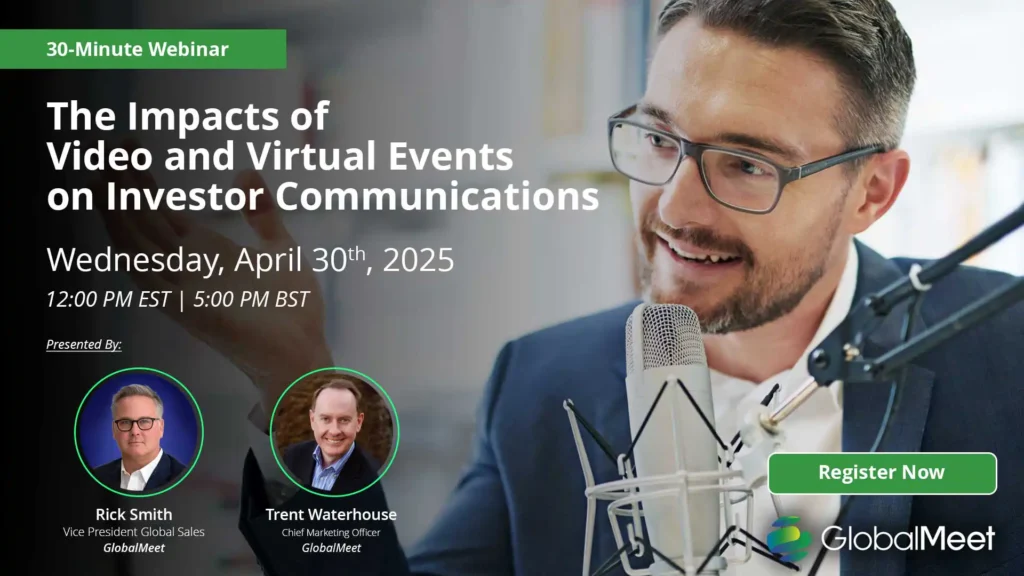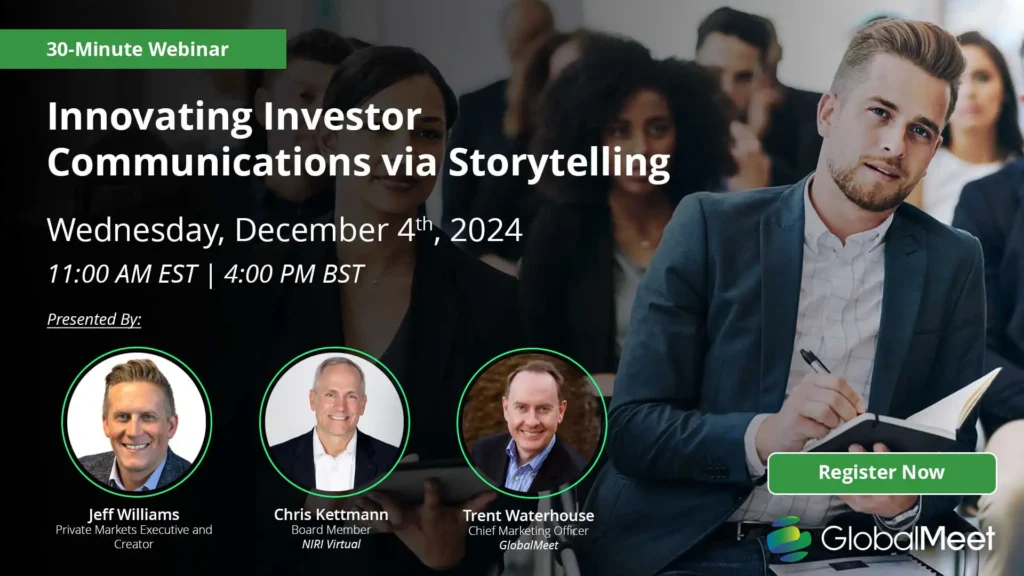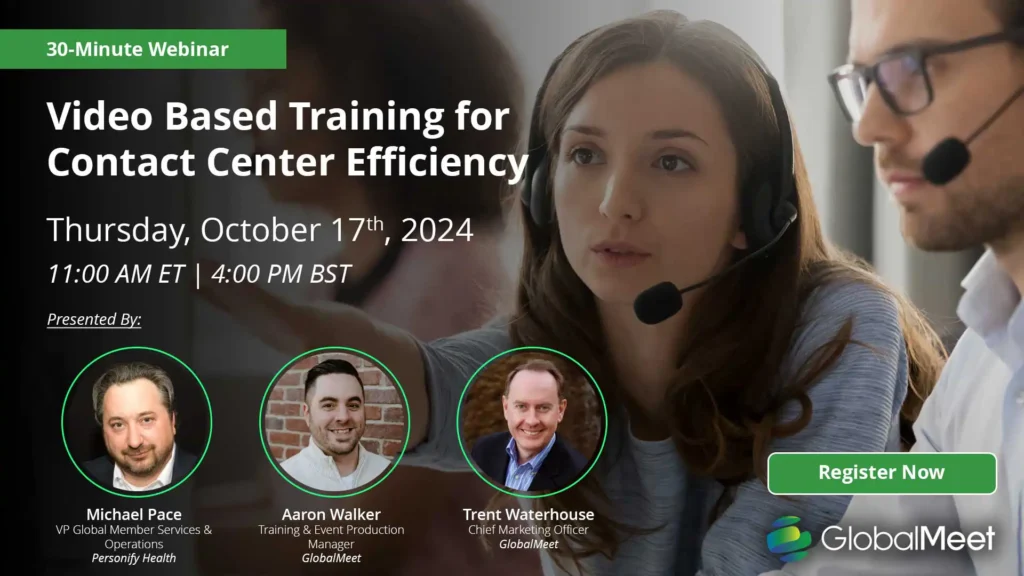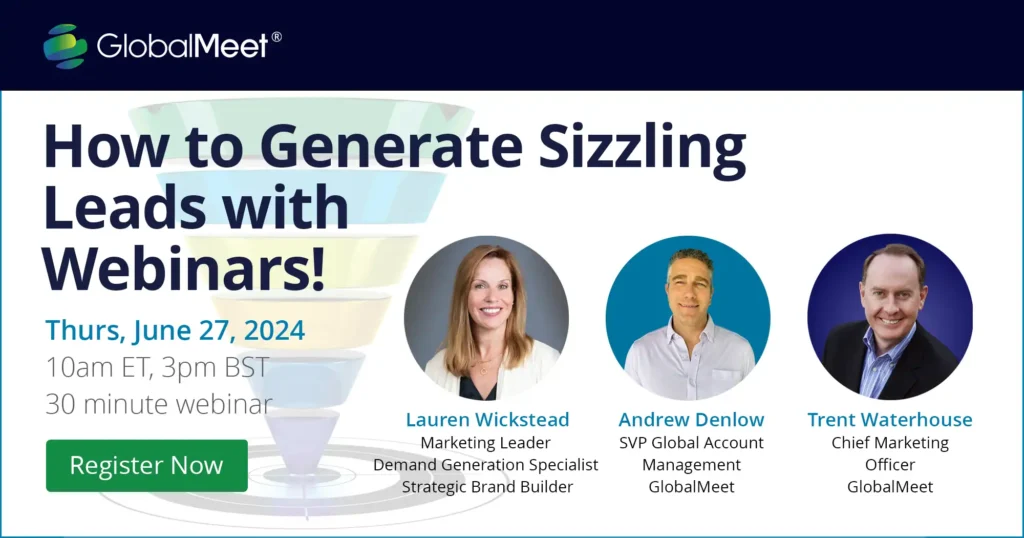
How to Plan a Virtual Event: A Step-by-Step Guide
- by GlobalMeet Blog Team
- ,
So you want to host a virtual event, huh? Perfect! But let’s not put the cart before the horse here—first, we have to actually plan the thing.
In this guide, we’ll explore the essentials of building a strong event team, creating engaging content and agendas, and the crucial steps of technical and rehearsal planning. From preparing presenters to finalizing event settings, this guide is designed to equip you with the necessary tools and insights for a successful virtual event.
Sound like a lot? Good, it should. A good virtual event isn’t just thrown together, even by professionals—like us here at GlobalMeet. After all, do you want to know how to plan a virtual event or how to plan a virtual event that people will love?
Let’s start out by clarifying the difference between virtual events and hybrid events, just to make sure we’re on the same page. Then, we’ll dive head first into the step-by-step guide on how to plan a virtual event.
Understanding Virtual vs. Hybrid Events
Virtual Events: The Digital Stage
Virtual events occur entirely online, accessible globally to anyone with an internet connection. These digital gatherings range from simple live streams to elaborate multi-day conferences with live speakers and breakout sessions. Their strength lies in inclusivity—reaching people irrespective of location, physical ability, or financial constraints. They offer a cost-effective, sustainable format, free from geographical limitations, and provide rich opportunities for data collection and brand awareness. Crucially, virtual events cater to diverse needs, from educational webinars to interactive social networking sessions.
Hybrid Events: Best of Both Worlds
Hybrid events blend in-person and virtual experiences, offering parallel participation whether attendees are on-site or joining remotely. Successful hybrid events ensure that both in-person and virtual attendees engage with the content equally, participate in discussions, and experience the event cohesively. These events are particularly effective for broad-reaching activities like industry-specific conferences, product launches, or educational seminars, where the aim is to combine the authenticity of face-to-face interactions with the wide reach of digital platforms.
Choosing the Right Format
The choice between virtual and hybrid formats hinges on your event’s objectives and audience. Virtual events are ideal when aiming for broad, global outreach or when logistics and budget constraints limit physical gatherings. Hybrid events shine in scenarios where you want to combine the intimacy and impact of in-person interactions with the extended reach of an online audience.
Embracing the strengths of each format allows you to tailor experiences that align with your goals, ensuring both engagement and effectiveness. Whether you choose the immersive world of virtual events or the dynamic blend of hybrid experiences, understanding these differences is key to planning successful, impactful events.
How to Plan a Virtual Event
Planning a virtual event requires a well-thought-out concept, and an even more meticulous plan of action. So below, we’ve broken down how to plan a virtual event into five basic steps.
- Building Your Event Team
- Creating Engaging Content and Agendas
- Technical and Rehearsal Planning
- Presenter Preparation and Coordination
- Finalizing Event Settings and Schedules
And there you have it: that’s how to plan a virtual event.
Alright, alright, there’s more to it. Here’s how we’ll elaborate: We’ll start by assembling a dynamic event team, each member playing a pivotal role in the event’s success. Then, we’ll delve into creating content that captivates and an agenda that keeps the audience engaged. Technical setup and rehearsals will ensure everything runs smoothly, while preparing presenters and fine-tuning event settings will lay the groundwork for a seamless experience. Each of these steps is integral, and we’ll explore them in detail to equip you with the tools for success.
Step 1: Building Your Virtual Event Team
A successful virtual event hinges on a well-coordinated team, each member playing a pivotal role in ensuring seamless execution.
Project Manager
The Project Manager is the backbone of your event, orchestrating the overall vision, timelines, and resources. They ensure that every aspect of the event aligns with strategic objectives, managing everything from initial planning to post-event analysis. Their role involves coordinating across various teams, resolving logistical challenges, and keeping the event on track.
Production Manager
The Production Manager is responsible for the technical aspects of the event. They work closely with the tech team to manage the platform, handle audio-visual elements, and ensure that all technical requirements are met. This role is crucial for troubleshooting technical issues and ensuring a smooth, glitch-free experience for participants.
Producer: The Live Event Conductor
During the event, the Producer takes the lead. They are responsible for the live execution of the event, managing the flow, transitions, and ensuring that each segment starts and ends on time. A great Producer can seamlessly blend different elements of the event, making the technology invisible to presenters and participants.
Content Coordinator and Marketing
The Content Coordinator oversees the event’s content, ensuring it is engaging, relevant, and well-paced. They work with speakers to fine-tune their presentations and align content with the event’s goals. The Marketing Team, on the other hand, drives awareness and attendance through strategic campaigns across various channels.
Step 2: Create Narrative Agendas and Compelling Content
Next On the Agenda: The Agenda
A well-structured agenda helps keep your audience engaged. Begin with a strong opening that captures attention, and space out your program to include a variety of sessions. Integrate interactive elements like live polls, Q&A sessions, and breakout rooms to foster attendee participation. Consider time zones for a global audience and keep sessions concise to maintain energy levels. Regular breaks are essential, especially for longer events, to prevent zoom fatigue. Close with a compelling session that leaves a lasting impression and encourages further engagement.
Gathering Speaker Materials
In the run-up to the event, ensure you collect all necessary materials from your speakers well in advance. This includes not only their presentation content but also bios, photos, and social media links. These elements are crucial not just for the event itself but also for promotional activities, helping to build anticipation and connect the audience with your speakers.
Crafting Effective Event Slides
If you want to know how to plan a virtual event and only remember one thing, make sure it’s this: the heart of a successful virtual event lies in its content.
Start by identifying the most impactful themes that resonate with your target audience. Incorporate a mix of formats—keynote speeches, panel discussions, interactive workshops—to maintain interest. Use storytelling to make presentations relatable and memorable. It’s crucial to include real-world examples, case studies, or live demonstrations to enrich the content. Ensure the content not only informs but also inspires and engages your audience.
A well-designed slide deck is more than just a visual aid; it’s a roadmap for your event. It should clearly outline the structure, maintaining a balance between information and engagement. Remember, the best slides complement the speaker, reinforcing their message without overshadowing it.
Optimizing Your Presentation Space
The physical space from where you present plays a subtle yet significant role. Ensure high audio quality with a good microphone or headset. Pay attention to your background—keep it clean and clutter-free. A messy backdrop will leave the attendees feeling icky. Same with your attire: dress in simple, solid colors to minimize distractions but portray professionalism and authority. This setup helps maintain focus on your content, ensuring your audience absorbs and trusts every word.
Incorporating these elements into your virtual event planning ensures a polished and professional experience, where every detail is aligned with your overarching goal of delivering an unforgettable virtual event.
Step 3: Technical and Rehearsal Planning
When it comes to virtual events, the devil is in the technical details. Ensuring a flawless technical setup is non-negotiable. This includes establishing robust broadcast channels for wider reach, such as Facebook Live, LinkedIn Live or YouTube, and hardwiring your internet connection for stability. A shaky connection is the quickest way to lose your audience’s attention and trust.
Equally crucial is the rehearsal process. Conducting at least one thorough rehearsal is essential to familiarize speakers with the presentation software and format. This dry run should replicate the live event conditions as closely as possible. Everyone involved should test their cameras, microphones, lighting, and any other equipment to iron out potential issues.
The webinar planning phase is also the perfect opportunity to practice transitions and content flow, ensuring that speakers feel confident and ready. Remember, a well-rehearsed event is more likely to run smoothly and keep your audience engaged from start to finish.
Step 4: Presenter Preparation and Coordination
Preparing your presenters is a critical step in the success of your virtual event. Begin by providing them with comprehensive best practices for using the webcast platform. It’s essential for presenters to be familiar with the technology to ensure a smooth delivery.
During rehearsals, focus on checking audio and video quality to ensure they are clear and professional. Encourage presenters to use the same technical setup during rehearsals as they will during the live event. A well-prepared presenter is confident and engaging, key to delivering a successful virtual session.
Step 5: Finalizing Event Settings and Schedules
- Configuring Webcast Software Settings: Ensure all technical aspects of the webcast software are properly set up. This includes audio and video settings, chat functionalities, poll creation, and other interactive features. It’s crucial to tailor these settings to suit the specific needs of your event.
- Scheduling Presenters: It’s vital to have presenters log in well before the event start time. Aim for a 30-60 minute early login to allow for any last-minute adjustments or troubleshooting. This window also provides an opportunity for presenters to acclimate to the virtual environment and interact with each other, fostering a more relaxed and confident presentation atmosphere.
- Final Checks and Balances:
Test all links and login credentials.
Verify that backup systems are in place for critical components.
Confirm that all content, such as slides and videos, is uploaded and functioning correctly.
By carefully managing these final steps, you can significantly reduce the risk of technical glitches and ensure a smooth, professional experience for both presenters and attendees. After you’ve successfully planned your virtual event, all that’s left to do is promote, execute, generate leads, and follow up!
In summary, when you’re exploring how to plan a virtual event, it involves five steps:
- Building Your Event Team: Assemble a team with roles like Project Manager, Production Manager, and Producer to ensure smooth coordination.
- Creating Engaging Content and Agendas: Develop captivating content and a well-paced agenda, balancing various session formats and incorporating interactive elements.
- Technical and Rehearsal Planning: Focus on technical setup, including stable internet connections and comprehensive rehearsals to familiarize speakers with the event format and technology.
- Presenter Preparation and Coordination: Prepare presenters with best practices and ensure they are comfortable with the technology and event format.
- Finalizing Event Settings and Schedules: Configure webcast software settings, schedule presenters for early arrival, and perform final checks for a seamless event.
Virtual Events with GlobalMeet
GlobalMeet stands as a premium solution, whether you’re organizing a simple event on your own or a complex, multi-day webinar requiring a full team. GlobalMeet provides access to a comprehensive event builder, a live event studio, and a range of customizable features.
We offer everything from self-service options with complete training to professionally managed events with expert event teams. Our platform is designed for various scenarios like corporate communications, investor relations, demand generation and more, ensuring an engaging and interactive experience for your audience.
See what the fuss is all about, and discover why five out of ten of the largest US banks trust GlobalMeet—watch a demo or contact us today!




